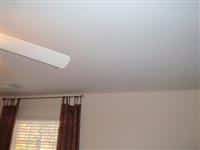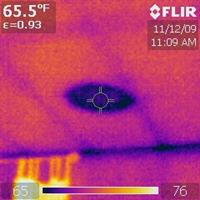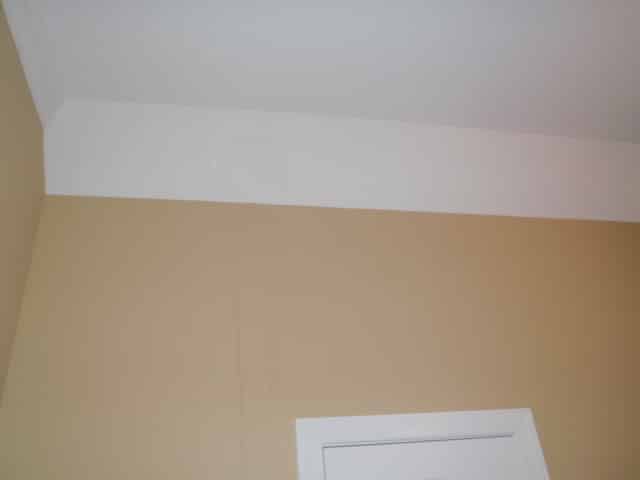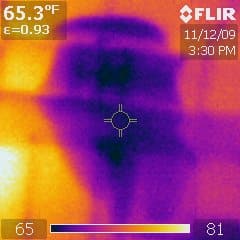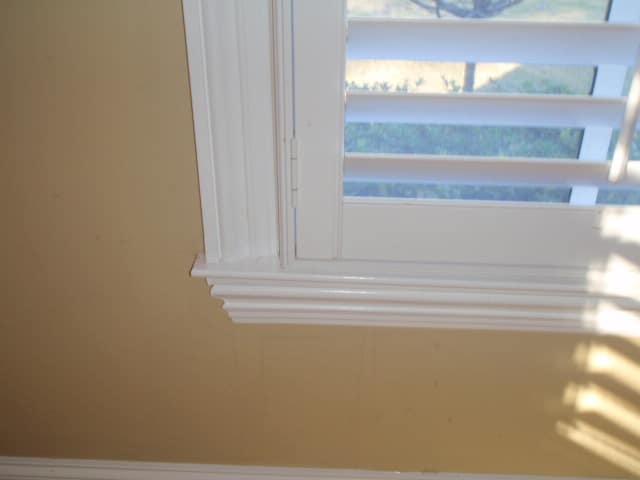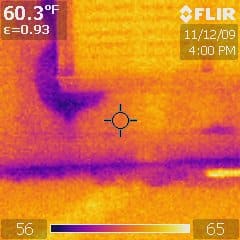Infrared Inspections Birmingham Vestavia Hills Alabaster AL
Looking for Infrared Inspections or a Thermal Imaging Inspector near Birmingham, Vestavia Hills, or the Alabaster, AL area?
Infrared Inspections and thermal imaging near Birmingham, Vestavia Hills, Alabaster, AL and more by Master Home Inspectors with more than 25 years of experience.
We’re here to help!
- Concerned with heat loss and air infiltration?
- Have under-performing radiant heating systems?
- Air-conditioner compressor leaks?
- Structural deficiencies in double-paned windows?
- Plumbing leaks?
- Hidden roof leaks?
- Impaired, missing, or moisture-ridden insulation?
- Moisture detection including foundational penetrations and structural wetness?
What is an infrared inspection?
A thermal imaging inspection (also known as infrared or IR inspection) uses non-invasive, state-of-the-art technology to generate reports not sufficiently covered by conventional visual or even physical inspections. An IR inspection report is just as important, if not more, than a standard home inspection report.
Thermal imaging works by detecting key temperature changes in a house and thus reveals areas that are or may prove to be problematic in the future. When performing the most comprehensive home inspection with thermal imaging in Birmingham, AL, our inspectors employ advanced methods and rely on cutting-edge equipment.
What we focus on during Thermal Imaging Home Inspections
Where there are known energy efficiency issues, a thermal imaging inspection can be helpful when specifically trying to locate spots where insulation is inadequate. During a thermal imaging inspection, we will typically start with the following areas, or with any already suspected areas:
- Light and electrical fixtures
- Windows and doors
- Attic, basement, cellar, crawlspaces
- Plumbing penetrations and bathroom traps
- Chimney flue and fireplace areas
- Dropped ceilings and soffits
- Visible areas of cracking between partition top plates and drywall
- Utility chases and baseboards

Thermal Imaging Home Inspections Provide Clarity To What You Can’t See
When purchasing a new home for the first time, buyers want to be absolutely certain that no hidden faults and safety hazards slip under the radar. While standard home inspections can detect most common structural defects, a thermal imaging home inspection can take it a step further, ensuring that your new Birmingham home hides no unpleasant surprises. At Griffith Home Analysis, we use top-of-the-line infrared equipment to identify problematic areas in a property and make sure you have nothing to worry about.
Why Griffith Home Analysis?
High Quality Reports
Customer First Attitude
Full Range of Services
24/7 Easy Scheduling
Flexible Appointments
Licensed, Certified, and Insured Inspectors
- Buyer's Home Inspections
- Pre-Listing Home Inspections
- Annual Home Maintenance Inspections
- Commercial Building Inspections
- New Construction Inspections
- Drone Inspections
- Infrared / Thermal Imaging
- Fortified Evaluations
- Mold Inspections
- Radon Inspections
- Stucco EIFS Inspection
- Home Inspection Birmingham AL
WHY USE INFRARED IMAGING?
A picture says a thousand words; infrared thermography is the only diagnostic technology that lets you instantly visualize and verify thermal performance. Infrared cameras show you thermal problems.
Our home inspectors carry infrared thermal cameras in our home inspections and have found them to be a valuable tool. Oftentimes when a substantial difference in the surface temperature of a building and the ambient air exists, then areas of the wall that are wet will have a different surface temperature. Different areas of surface temperature can be observed on a thermal camera. These differences can sometimes help identify moisture leakage, overheating electrical components, or missing insulation.
While thermal cameras have limitations and are not magic devices, the thermal camera has proven to be another valuable diagnostic tool to use when the conditions are right. Infrared thermal cameras can’t see through walls but they can see the surface temperature of the wall that may be affected by conditions inside the wall. However, one limitation we have found is the surface temperatures in a home inspection are greatly affected by many other factors that make it difficult to use the cameras in some circumstances. Notably, the exterior and interior areas being scanned when looking for air leakage and moisture leakage show best when a good temperature differential exists (20 degrees or better for example) between the interior surface and exterior surface. We also find many factors which can interfere with the beneficial use of a thermal camera.
For instance: air from an HVAC system blowing within the home, lights, and reflections from lights, windows, and reflections from windows, shade from furnishings, etc. Additionally the exterior environments such as shade and sun and rain on the exterior of the walls/roof. Lastly and most important if we are conducting a moisture inspection then the amount of rainfall, how recent the rainfall, how long the rainfall, the force of the rainfall, and how intense the rainfall all contribute to the ability to reliably use an infrared thermal camera during a home inspection to detect leakage at the wall or roof also.
We have found infrared thermal cameras a useful tool and carry them on home inspections for primary scans in some instances but because of the limitations in a typical home inspection, we don’t sell the home inspection as a thermal inspection.
Here are some examples of recent observations during inspections:
Ceiling leak below a chimney in a bedroom.
Ceiling leak below a roof valley in a bedroom.
Wall leak below a window in a bedroom

Overheated electrical breaker in an electrical panel. 193 degrees is too hot for a breaker.
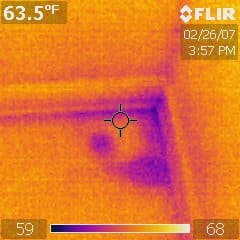
Wet floor from basement water leak under carpet.
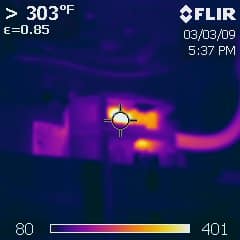
Overheated main breaker in an electrical panel. 303 degrees is dangerously hot and an likely fire hazard.
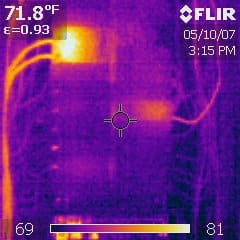
Overheated electrical breaker in an electrical panel.
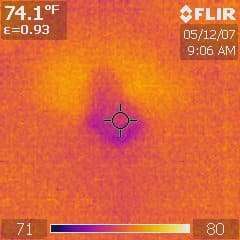
Shower pan leak above a breakfast room ceiling.
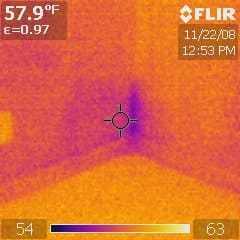
Basement wall leak behind drywall.
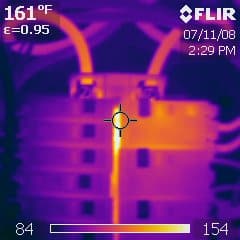
Overheated main buss in an electrical panel.
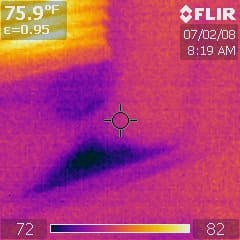
Leak below a window in a bedroom.
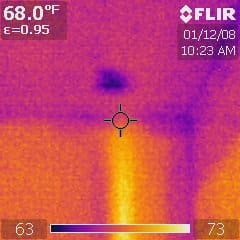
Ceiling leak from shower pan leak of a second story bathoom shower
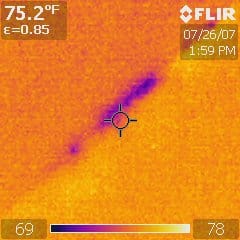
Basement wall leak.
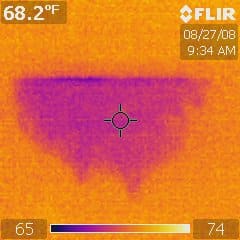
Basment leak on the wall from the ceiling.
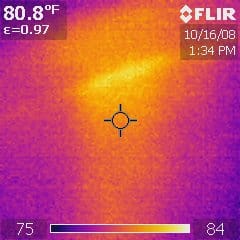
Ceiling leak from leaking hot water pipe in a wall. The pipe had been damaged by a wall nail.
FAQ
What is an infrared thermal camera?
Special cameras that can observe energy in an invisible infrared part of the light spectrum that radiates from building materials can be used to assist in evaluating certain conditions in a home inspection or building inspection. The radiation that we see on the infrared camera is thermal radiation or heat. The infrared thermal camera measures the temperature on the surface we are observing with the camera and converts this radiating heat to a visible picture. Modern infrared thermal cameras have excellent resolution with some expensive thermal cameras capable of thermal pictures at a similar resolution as a typical simple camera.
Can an Infrared camera actually see through walls?
In short no. The camera is observing the surface of the area viewed only. Often the conditions in the wall that affect the surface will be evident as we evaluate what the camera sees on the surface. As evidenced in the example infrared thermal photos above that were taken in previous home inspections.
Can an infrared thermal camera be used in a home inspection?
Yes, it’s a good diagnostic tool for a home inspector however virtually anything or condition that affects a surface’s temperature can potentially interfere with accurate observations (i.e. windows, lights, vent registers, even humans), and this limits the use and accuracy. A true infrared inspection of a home should be conducted under controlled conditions usually before the sun comes up or after it has gone down among other preparations. The camera can be useful to find leakage as well as overheated electrical, and missing insulation.
Can an infrared camera see water in a wall from rain?
Yes and no. Under ideal conditions, water leakage in a wall may be visible. Typically a small leak under a window or roof line does not show up during a standard home inspection. Heavy leaks under the right conditions can be viewed on a thermal camera. See some examples of what we have found in home inspections in the above photos.
Home & Commercial Building Inspectors Focusing on Meticulous Inspections
20,000+ HOME INSPECTIONS In ALABAMA
Reviews From Happy Customers
Get Started Today!
We'd be happy to provide you with a no-cost, no-obligation price quote to inspect your home or building.
Or you can go ahead and schedule an inspection.


